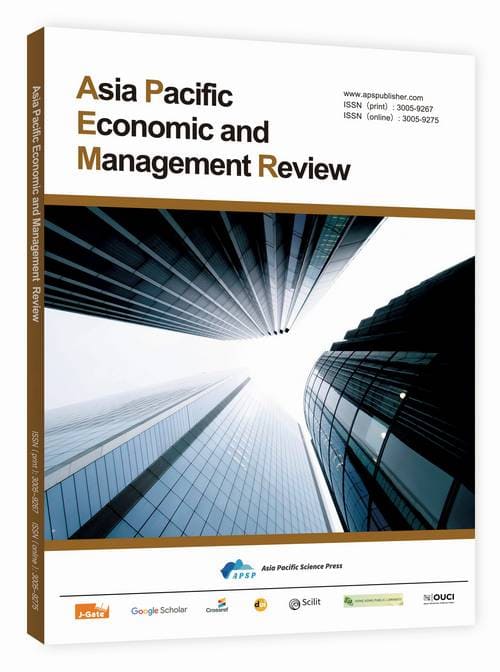The Effect of Readability of Listed Company Prospectuses on IPO Breaks: Evidence from the Shanghai Stock Exchange in China
DOI:
https://doi.org/10.62177/apemr.v2i5.595Keywords:
The Readability of Prospectus, IPO Break, Information AsymmetryAbstract
Using text analysis methods, this study analyzed the prospectuses of A-share listed companies on the Shanghai Stock Exchange that went public between 2014 and 2024, retrieved from the SSE website. By constructing readability metrics through an indicator-based approach, the relationship between the readability of Chinese text and the occurrence of initial public offering breaks on the first trading day was examined. The research found that, after controlling for industry and time fixed effects, there was a negative correlation between the readability of listed companies' prospectuses and the incidence of IPO breaks. This relationship was mediated through underwriter behavior. After a series of robustness checks, the above conclusion remained valid. Further research revealed that the degree of negative correlation between prospectus readability and IPO price breaks differed before and after the implementation of the registration-based IPO system, as well as when classified by the nature of listed enterprises. This finding provides a new perspective for research on factors influencing IPO pricing, which is beneficial for regulatory agencies to further standardize the information disclosure content of listed companies' prospectuses and also conducive to the development of capital markets.
Downloads
References
Yu, Z. (2022), “Financial report readability and accounting conservatism”, Journal of Risk and Financial Management, Vol. 15 No. 10, p. 454, Doi: 10.3390/jrfm15100454.
Daniel, K., Hirshleifer, D., & Subrahmanyam, A. (1998), “Investor psychology and security market under- and overreactions”, Journal of Finance, 53(6), 1839–1885.
Hirshleifer, D. (2001), “Investor psychology and asset pricing”, Journal of Finance, 56(4), 1533–1597.
Zhang, X. F. (2006a), “Information uncertainty and stock returns”, Journal of Finance, 61(1), 105–137.
Zhang, X. F. (2006b), “Information uncertainty and analyst forecast behavior”, Contemporary Accounting Research, 23(2), 565–590.
Boulton, T. J.; S. B. Smart; and C. J. Zutter., (2011), “Earnings Quality and International IPO Underpricing”, Accounting Review, 86, 485–505.
Hong, H. A.; M. Hung; and G. J. Lobo., (2014), “The Impact of Mandatory IFRS Adoption on IPOs in Global Capital Markets.” Accounting Review, 89, 1365–1397.
Dale, E., and J. S. Chall., (1949), “The concept of readability”, elementary English, Pages: 19-26.
Tinker, M. A., G. R. Klare, (1955), “Review of Know Your Reader”, Journal of Educational Psychology, 46(5), 318–319.
Eugene Baker, H. and Kare, D.D., (1992), “Relationship Between Annual Report Readability and Corporate Financial Performance”, Management Research News, Vol. 15 No. 1, pp. 1-4.
Stigler, G. J., (1964), “Public regulation of the securities markets”, Bus. Law., 19, 721.
François Derrien, Kent L. Womack, (2003), “Auctions vs. Bookbuilding and the Control of Underpricing in Hot IPO Markets”, The Review of Financial Studies, Volume 16, Issue 1, Pages 31–61.
Marc Goergen, Arif Khurshed, Luc Renneboog, (2009), “Why are the French so different from the Germans? Underpricing of IPOs on the Euro New Markets”, International Review of Law and Economics, Volume 29, Issue 3, Pages 260-271.
Kevin K. Boeh, Craig Dunbar, (2016), “Underwriter deal pipeline and the pricing of IPOs”, Journal of Financial Economics, Volume 120, Issue 2, Pages 383-399, ISSN 0304-405X.
Fazzari S, Hubbard R G, Petersen B. (1988), “Investment, financing decisions, and tax policy”, The American economic review, 78(2): 200-205.
Li, R., Liu, W., Liu, Y. and Tsai, S.-B. (2018), “IPO underpricing after the (2008), financial crisis: a study of the Chinese stock markets”, Sustainability, Vol. 10 No. 8, p. 2844.
Dyck, A., Volchkova, N. and Zingales, L. (2008), “The corporate governance role of the media: evidence from Russia”, The Journal of Finance, Vol. 63 No. 3, pp. 1093-1135.
Dan Bernhardt, Kostas Koufopoulos, Giulio Trigilia,(2022), “Separating equilibria, underpricing and security design”, Journal of Financial Economics, Volume 145, Issue 3, Pages 788-801, ISSN 0304-405X.
Xiaoding Liu, Jay R. Ritter, (2011), “Local underwriter oligopolies and IPO underpricing”, Journal of Financial Economics, Volume 102, Issue 3, Pages 579-601, ISSN 0304-405X.
Laura Xiaolei Liu, Ruichang Lu, Ann E. Sherman, Yong Zhang, (2023), “IPO underpricing and limited attention: Theory and evidence”, Journal of Banking & Finance, Volume 154, 106932, ISSN 0378-4266.
Arnold, T., Fishe, R. P., & North, D., (2010), “The effects of ambiguous information on initial and subsequent IPO returns”, Financial Management, 39(4), 1497-1519.
Hanley, K. W., and G. Hoberg,(2012), “Litigation risk, strategic disclosure and the underpricing of initial public offerings”, Journal of Financial Economics ,103:235–54.
Hun-Tong Tan, Elaine Ying Wang, Bo Zhou, (2015), “How Does Readability Influence Investors' Judgments? Consistency of Benchmark Performance Matters”, The Accounting Review. 90 (1): 371–393.
Bloomfield R. J., (2008), “Discussion of annual report readability, current earnings, and earnings persistence”, Journal of Accounting and Economics, 45):248 ~ 252.
Grossman S. J., Stiglitz J. E., (1980), “On the impossibility of informationally efficient markets”, American Economic Review, 70): 393 ~ 408.
H. Scott Asay, Robert Libby, Kristina Rennekamp, (2018), “Firm performance, reporting goals, and language choices in narrative disclosures”, Journal of Accounting and Economics,Volume 65, Issues 2–3, Pages 380-398.
Li F. (2008), “Annual report readability, current earnings, and earnings persistence”, Journal of Accounting and Economics, 45 (2/3): 221-247.
Biddle,G. C., G. Hilary, and R. S. Verdi, (2009), “How Does Financial Reporting Quality Relate to Investment Efficiency?”, Journal of Accounting and Economics, 48(2-3): 112-131.
Lehavy, R., F. Li, and K. Merkley, (2011), “The Effect of Annual Report Readability on Analyst Following and the Properties of Their Earnings Forecasts”, Accounting Review , 86(3): 1087-1115.
LOUGHRAN, T. and MCDONALD, B. (2014), “Measuring Readability in Financial Disclosures”, The Journal of Finance, 69: 1643-1671.
Haiyu Yan, (2024), “Environmental information disclosure, earnings quality and the Readability and Emotional Tendencies of Management Discussion and Analysis”, Finance Research Letters, Volume 60,104913,ISSN1544-6123.
Lingli Yu and Q. Cao and Yunhan Mou and Hongyu Du, (2020), “Chinese FOG Index: the Readability of Information Disclosure in Chinese Listed Companies”, Proceedings of the 2020 5th International Conference on Mathematics and Artificial Intelligence.
Hatem Rjiba, Samir Saadi, Sabri Boubaker, Xiaoya (Sara) Ding, (2021), “Annual report readability and the cost of equity capital”, Journal of Corporate Finance, Volume 67, 101902, ISSN 0929-1199.
Minkwan Ahn, Doowon Jung, Jeong-Taek Kim, Woo-Jong Lee, Hee-Yeon Sunwoo,(2023), “Do more readable sustainability reports provide more value-relevant information to shareholders?”, Finance Research Letters,Volume 57,1 04154, ISSN 1544-6123.
Lo, K., F. Ramos, and R.Rogo, (2017), “Earnings Management and Annual Report Readability”, Journal of Accounting and Economics, 63 (1): 1 - 25.
Merkl-Davies D M, Brennan N M, McLeay S J., (2011), “Impression management and retrospective sense-making in corporate narratives”, Accounting, Auditing & Accountability Journal, (2011), 24(3): 315-344.
Rameezdeen, R., and C. Rajapakse. 2007. “Contract Interpretation: The Impact of Readability”, Construction Management and Economics, 25(7) : 729-737.
Courtis, J.K., (1998), “Annual report readability variability: tests of the obfuscation hypothesis”, Account. Audit. Account, J. 11 (4), 459–472.
Subramanian, R., Insley, R. G., & Blackwell, R. D. (1993), “Performance and Readability: A Comparison of Annual Reports of Profitable and Unprofitable Corporations”, The Journal of Business Communication, 30(1), 49-61.
BUSHEE, B.J., GOW, I.D. and TAYLOR, D.J., (2018), “Linguistic Complexity in Firm Disclosures: Obfuscation or Information?”, Journal of Accounting Research, 56: 85-121.
Mostafa Monzur Hasan, (2020), “Readability of Narrative Disclosures in 10-K Reports: Does Managerial Ability Matter?”, European Accounting Review, 29:1, 147-168.
Minkwan Ahn, Doowon Jung, Jeong-Taek Kim, Woo-Jong Lee, Hee-Yeon Sunwoo,(2023), “Do more readable sustainability reports provide more value-relevant information to shareholders?”, Finance Research Letters, Volume 57, 104154, ISSN 1544-6123.
Xuelian Bai, Yi Dong & Nan Hu, (2019), “Financial report readability and stock return synchronicity”, Applied Economics, 51:4, 346-363.
Mun G S, Jang S., (2019), “Restaurant firms’ IPO motivations and post-IPO performances”, International Journal of Contemporary Hospitality Management, 31(9): 3484-3502.
Stoll HR, Curley AJ., (1970), “Small Business and the New Issues Market for Equities”, Journal of Financial and Quantitative Analysis, 5(3):309-322.
François Derrien, Kent L. Womack, (2003), “Auctions vs. Bookbuilding and the Control of Underpricing in Hot IPO Markets”, The Review of Financial Studies, Volume 16, Issue 1, Pages 31–61.
Lawrence M. Benveniste, Paul A. Spindt, (1989), “How investment bankers determine the offer price and allocation of new issues”, Journal of Financial Economics, Volume 24, Issue 2, Pages 343-361.
Marc Goergen, Arif Khurshed, Luc Renneboog, (2009), “Why are the French so different from the Germans? Underpricing of IPOs on the Euro New Markets”, International Review of Law and Economics, Volume 29, Issue 3, Pages 260-271.
Lewellen, J., Nagel, S., & Shanken, J.,(2010), “A skeptical appraisal of asset pricing tests”, Journal of Financial economics, 96(2), 175-194.
Guldiken, O., Tupper, C., Nair, A. and Yu, H. (2017), “The impact of media coverage on IPO stock performance”, Journal of Business Research, Vol. 72, pp. 24-32.
Arnold, T., Fishe, R.P.H. and North, D. (2010), “The effects of ambiguous information on initial and subsequent IPO returns”, Financial Management, Vol. 39 No. 4, pp. 1497-1519.
Wang, C.Y. and Wu, J.W. (2015), “Media tone, investor sentiment and IPO pricing”, Journal of Financial Research, Vol. 9, pp. 174-189.
Cook, D.O., Kieschnick, R. and Ness, R.A.V. (2006), “On the marketing of IPOs”, Journal of Financial Economics, Vol. 82 No. 1, pp. 35-61.
Tetlock, P.C. (2007), “Giving content to investor sentiment: the role of media in the stock market”, The Journal of Finance, Vol. 62 No. 3, pp. 1139-1168.
Senter, R. J., & Smith, E. A. ,(1967), “Automated readability index (pp. 1-14)”, Technical report, DTIC document.
Coffee, J. C., Jr. (1984), “Market failure and the economic case for a mandatory disclosure system”, Virginia Law Review, 70:717–53.
Carter R B, Dark F H, Singh A K., (1998), “Underwriter reputation, initial returns, and the long-run performance of IPO stocks”, Journal of Finance, 53(1): 285-311.
Downloads
How to Cite
Issue
Section
License
Copyright (c) 2025 Ruining Li; Jiangjiao Duan

This work is licensed under a Creative Commons Attribution-NonCommercial 4.0 International License.
DATE
Accepted: 2025-09-11
Published: 2025-09-19

















